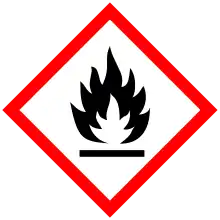1-Pentanol
1-Pentanol, (or n-pentanol, pentan-1-ol), is an alcohol with five carbon atoms and the molecular formula C5H11OH.[2] 1-Pentanol is a colorless liquid with a distinctive aroma. It is the straight-chain form of amyl alcohol, one of 8 isomers with that formula.
| Names | |
|---|---|
| IUPAC name
Pentan-1-ol[1] | |
| Identifiers | |
3D model (JSmol) |
|
| 1730975 | |
| ChEBI | |
| ChEMBL | |
| ChemSpider | |
| ECHA InfoCard | 100.000.684 |
| EC Number |
|
| 25922 | |
| KEGG | |
| MeSH | n-Pentanol |
PubChem CID |
|
| RTECS number |
|
| UNII | |
| UN number | 1105 |
CompTox Dashboard (EPA) |
|
| |
| |
| Properties | |
| C5H12O | |
| Molar mass | 88.150 g·mol−1 |
| Density | 0.811 g cm−3 |
| Melting point | −78 °C; −109 °F; 195 K |
| Boiling point | 137 to 139 °C; 278 to 282 °F; 410 to 412 K |
| 22 g L−1 | |
| log P | 1.348 |
| Vapor pressure | 200 Pa (at 20 °C) |
| -67.7·10−6 cm3/mol | |
Refractive index (nD) |
1.409 |
| Thermochemistry | |
Heat capacity (C) |
207.45 J K−1 mol−1 |
Std molar entropy (S |
258.9 J K−1 mol−1 |
Std enthalpy of formation (ΔfH⦵298) |
−351.90–−351.34 kJ mol−1 |
Std enthalpy of combustion (ΔcH⦵298) |
−3331.19–−3330.63 kJ mol−1 |
| Hazards | |
| GHS pictograms |   |
| GHS Signal word | Warning |
| H226, H315, H332, H335 | |
| P261 | |
| NFPA 704 (fire diamond) | |
| Flash point | 49 °C (120 °F; 322 K) |
| 300 °C (572 °F; 573 K) | |
| Related compounds | |
Related compounds |
Hexane |
Except where otherwise noted, data are given for materials in their standard state (at 25 °C [77 °F], 100 kPa). | |
| Infobox references | |
The hydroxyl group (OH) is the active site of many reactions. The ester formed from 1-pentanol and butyric acid is pentyl butyrate, which smells like apricot. The ester formed from 1-pentanol and acetic acid is amyl acetate (also called pentyl acetate), which smells like banana.
In 2014, a study was conducted comparing the performance of diesel fuel blends with various proportions of pentanol as an additive. While gaseous emissions increased with higher concentrations of pentanol, particulate emissions decreased.[3]
Pentanol can be used as a solvent for coating CDs and DVDs.
Pentanol can be prepared by fractional distillation of fusel oil. To reduce the use of fossil fuels, research is underway to develop cost-effective methods of producing (chemically identical) bio-pentanol with fermentation.
References
- "n-pentanol - Compound Summary". PubChem Compound. USA: National Center for Biotechnology Information. 26 March 2005. Identification and Related Records. Retrieved 10 October 2011.
- CRC Handbook of Chemistry and Physics 65Th Ed.
- Wei, Liangjie & Cheung, C.s & Huang, Zuohua. (2014). Effect of n-pentanol addition on the combustion, performance and emission characteristics of a direct-injection diesel engine. Energy. 70. 10.1016/j.energy.2014.03.106.
